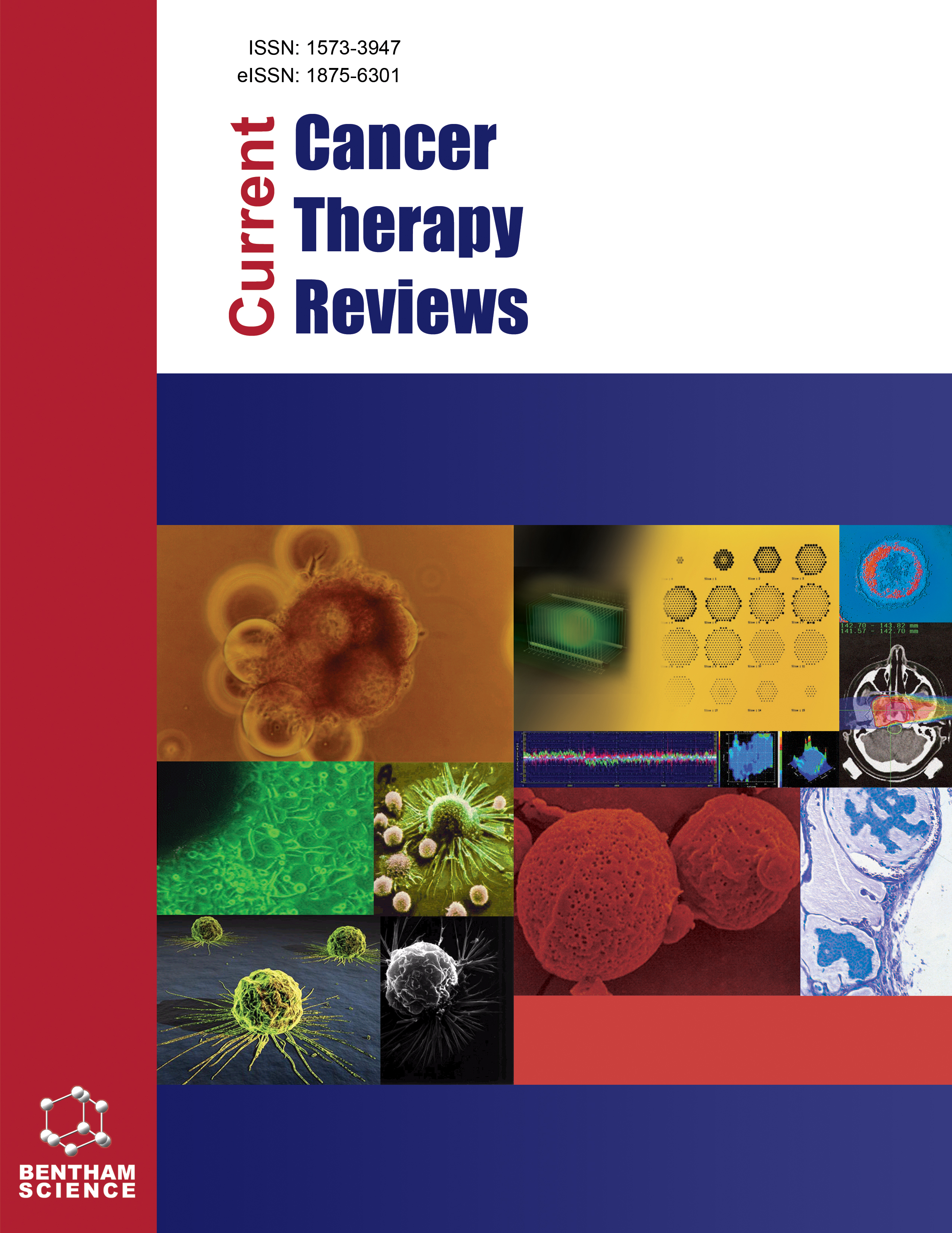- Home
- A-Z Publications
- Current Cancer Therapy Reviews
- Previous Issues
- Volume 20, Issue 5, 2024
Current Cancer Therapy Reviews - Volume 20, Issue 5, 2024
Volume 20, Issue 5, 2024
-
-
Therapeutic Potential and Pharmacological Activities of Moscatilin in Medicine for the Treatment of Cancers and other Human Complication: A Review of the Active Components of Dendrobium Species
More LessBackground: Plant-derived byproducts have been used to treat numerous kinds of human complications in medicine since a very early age. Moscatilin is a bibenzyl compound found to be present in Dendrobium. Moscatilin, also called 4,4′-dihydroxyl-3,3′,5-trimethoxybibenzyl has potential benefits in medicine for the treatment of ovarian, lung, breast, esophageal, hepatic, colorectal, pancreatic and neck squamous cancer. Read More
-
-
-
Aptamer-guided Selective Delivery of Therapeutics to Breast Cancer Cells Expressing Specific Biomarkers
More LessAuthors: Swaroop K. Pandey, Mradula Parul and Manikandan SanthanamCancer biomarkers or tumor-associated antigens (TAA) are the focus area of current research in cancer biology for diagnosis, prognosis, screening, and targeted treatments. Breast cancer is the second most common type of cancer, affecting women more than men. Conventional methods and antibody-targeted therapies are less effective and suffer systemic cytotoxicity, poor tissue sensitivity, low penetration capacity, and redu Read More
-
-
-
A Comprehensive Review of Systemic Targeted Therapies in Cancer Treatment
More LessCancer is one of the significant healthcare challenges in today’s world, even after advancements in modern science, including oncology. The complex nature of the disease, which involves multiple proteins and pathways, poses a substantial challenge in drug discovery. Several therapeutic options have emerged in the last decade. Systemic cancer therapies began with the advent of chemotherapy and were revolutionized w Read More
-
-
-
Multifaceted Understandings of Cancer: A Review of Disease Mechanisms and Therapies
More LessCancer is a condition in which aberrant cells continue to divide uncontrollably, causing tissue to be destroyed. Different cancer stages have been identified by researchers, suggesting that a number of gene alterations are involved in the etiology of cancer. Unusual cell proliferation is brought on by these gene alterations. A crucial role in the acceleration of cell proliferation is played by genetic diseases brought on by heredity o Read More
-
-
-
Upgrading Melanoma Treatment: Promising Immunotherapies Combinations in the Preclinical Mouse Model
More LessBackground: Melanoma, known for its high metastatic potential, does not respond well to existing treatments in advanced stages. As a solution, immunotherapy-based treatments, including anti-PD-1/L1 and anti-CTLA-4, have been developed and evaluated in preclinical mouse models to overcome resistance. Although these treatments display the potential to suppress tumor growth, there remains a crucial requirement fo Read More
-
-
-
Unusual Scenario: Ipsilateral Pelvic Lymph Node Metastasis in High- Grade Serous Ovarian Carcinoma without Peritoneal Extension - A Case Report
More LessAuthors: Naina Kumar, Ashutosh Rath, Mishu Mangla and Subhrajyoti RoyIntroduction: Ovarian cancers are the third most common gynecological cancers worldwide with serous carcinomas being the most common subtype with 90% of them as high-grade carcinomas. Case Presentation: In the present case report a 60 years postmenopausal, nulliparous woman presented with complaints of bleeding per vaginum for 1-2 months with a left-sided solid-cystic ovarian mass of size 4x5 cm and ipsilate Read More
-
-
-
Abdomen Malignant Myxoid Leiomyosarcoma with PDGFRA and TP53 Missense Mutation: A Case Report
More LessAuthors: Yao-xuan Li, Jian-ping Yu, Yan-qing Gong, Hai-fu Huang and Xian-lin WuBackground: Malignant myxoid leiomyosarcoma (MMLS) is most commonly found in the uterus but can also occur in other areas, such as the extremities, vulva, chest wall, and abdominal cavity. This cancer is more prevalent in women and has a poor prognosis with a high rate of recurrence and a significant percentage of metastasis. Case Representation: Herein, we report the case of a 64-year-old female patient Read More
-
Volumes & issues
-
Volume 21 (2025)
-
Volume 20 (2024)
-
Volume 19 (2023)
-
Volume 18 (2022)
-
Volume 17 (2021)
-
Volume 16 (2020)
-
Volume 15 (2019)
-
Volume 14 (2018)
-
Volume 13 (2017)
-
Volume 12 (2016)
-
Volume 11 (2015)
-
Volume 10 (2014)
-
Volume 9 (2013)
-
Volume 8 (2012)
-
Volume 7 (2011)
-
Volume 6 (2010)
-
Volume 5 (2009)
-
Volume 4 (2008)
-
Volume 3 (2007)
-
Volume 2 (2006)
-
Volume 1 (2005)
Most Read This Month
Article
content/journals/cctr
Journal
10
5
false
en


